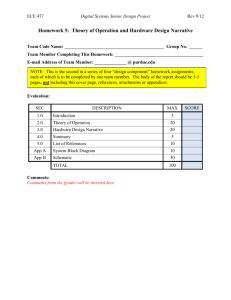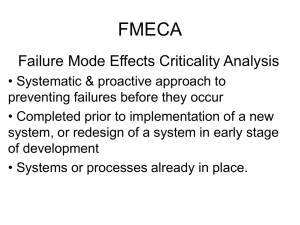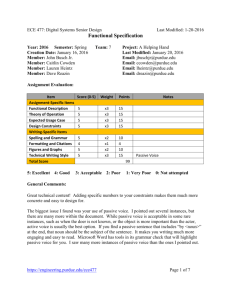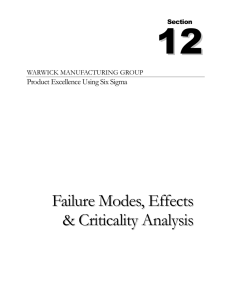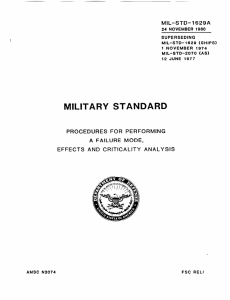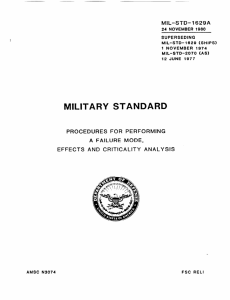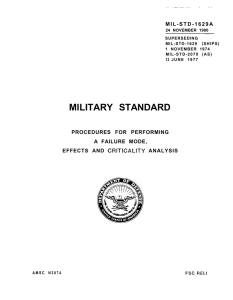Assignment Template
advertisement
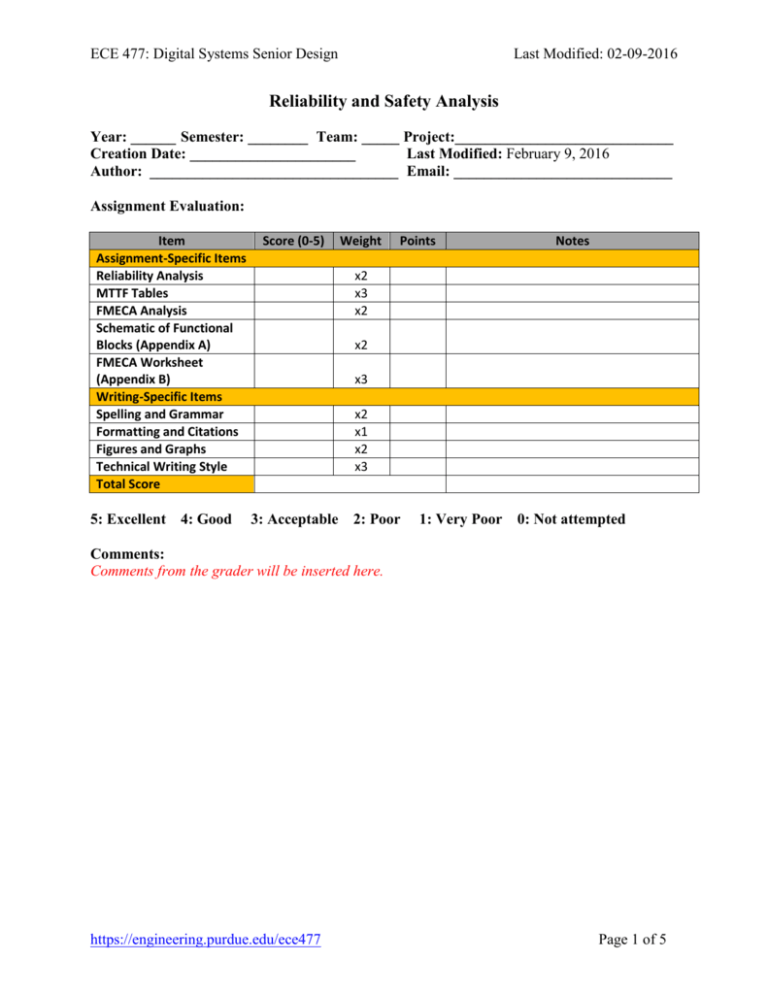
ECE 477: Digital Systems Senior Design Last Modified: 02-09-2016 Reliability and Safety Analysis Year: ______ Semester: ________ Team: _____ Project:_____________________________ Creation Date: ______________________ Last Modified: February 9, 2016 Author: _________________________________ Email: _____________________________ Assignment Evaluation: Item Assignment-Specific Items Reliability Analysis MTTF Tables FMECA Analysis Schematic of Functional Blocks (Appendix A) FMECA Worksheet (Appendix B) Writing-Specific Items Spelling and Grammar Formatting and Citations Figures and Graphs Technical Writing Style Total Score 5: Excellent 4: Good Score (0-5) Weight Points Notes x2 x3 x2 x2 x3 x2 x1 x2 x3 3: Acceptable 2: Poor 1: Very Poor 0: Not attempted Comments: Comments from the grader will be inserted here. https://engineering.purdue.edu/ece477 Page 1 of 5 ECE 477: Digital Systems Senior Design Last Modified: 02-09-2016 1.0 Reliability Analysis Choose 3-5 components in your design that are most likely to fail (voltage regulators, power MOSFETs, etc. – basically anything operating above room temperature). The microcontroller and any other similarly high complexity ICs should be included. Such devices are not always the hottest on your board, they are usually the most complicated and have the most I/O pins. Be sure to briefly explain the reasons for your selections. Perform calculations to determine the number of failures per 106 hours and mean time to failure (MTTF) for each component, making any reasonable assumptions where necessary. State the model used and any assumptions you had to make. For each component you analyzed, present the parameters you used and the results obtained in a tabular format like the following: Parameter name Description C1 πT Die complexity Temperature coeff. Value Comments regarding choice of parameter value, especially if you had to make assumptions. Entire design: Summarize conclusions about the reliability of these components and/or the circuit in general. Suggest design or analysis refinements that would realistically improve the reliability of the design. 2.0 Failure Mode, Effects, and Criticality Analysis (FMECA) Failure Modes: Divide your schematic into functional blocks (e.g. power circuits, sensor blocks, microcontroller block) – include this illustration as Appendix A Break the schematic into small enough blocks so that details are readable. Determine all possible failure conditions of each functional block. Indicate the components that could possibly be responsible for such a failure (e.g., a shorted bypass capacitor might cause a voltage drop, but cannot cause a voltage increase). Effects: For each failure mode above, determine the possible effects, if any, on any major components in other parts of the design (e.g., damage the microcontroller or fry a resistor) as well as effects on the overall operation of the project (e.g, audio volume increases to maximum). For some failure modes, it is acceptable to declare the effects unpredictable. “Method of detection” of a particular failure mode should be observable from the operation of the device, unless there is particular circuitry intended to detect such a failure. Criticality: Begin by defining at least two criticality levels for types of failures in the output of your design. Define an acceptable failure rate for each level of failure. These are up to you and somewhat arbitrary, but keep in mind 10-9 is standard for any failure that could potentially injure the user. Failures not affecting user safety do not usually require 10-9. FEMCA Worksheet: Include your completed FEMCA Worksheet as Appendix B. In the body of the report, explain your choice of criticality levels and any assumptions that affected your https://engineering.purdue.edu/ece477 Page 2 of 5 ECE 477: Digital Systems Senior Design Last Modified: 02-09-2016 analysis of several failure modes. Assumptions affecting just individual failure modes can be included in the comments in the table. 3.0 Sources Cited: Throughout this and other papers, use of the IEEE citation style should be used. Use of embedded hyperlinks for all web-based sources is required. A reference to the IEEE citation style format is provided here. NOTE: MIL-HDBK-217F should be among the sources teams cite, as well as relevant component datasheets https://engineering.purdue.edu/ece477 Page 3 of 5 ECE 477 Digital Systems Senior Design Project Spring 2009 Appendix A: Schematic Functional Blocks Divide schematic into subsystems and present each subsystem with a schematic that is easily readable on 8.5 x 11” paper. -4- ECE 477 Digital Systems Senior Design Project Spring 2009 Appendix B: FMECA Worksheet For each group of failures corresponding to one subsystem, make a separate table and label it with the name of the corresponding subsystem. Add more rows to this table as necessary to provide a complete analysis. Failure No. Failure Mode Possible Causes Failure Effects Method of Detection Criticality Remarks It is not necessary to calculate the probability of each failure mode. These numbers would usually be taken from the reliability analysis, but since you are not performing a complete analysis, they do not need to be included in your FMECA worksheet. -5-
